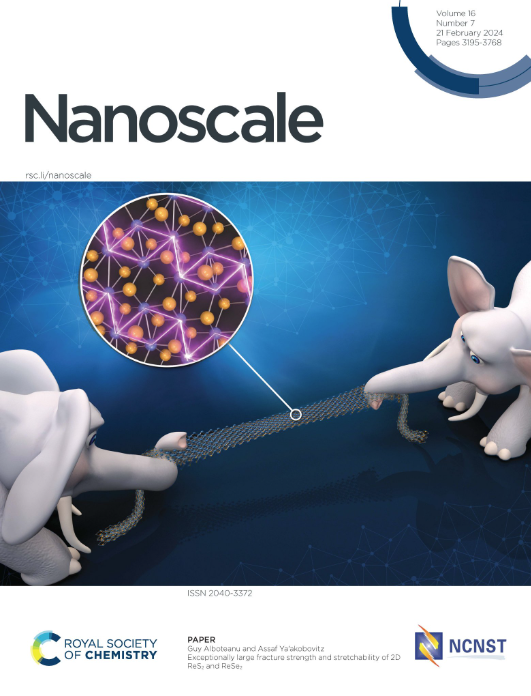在碳纳米管上热分解合成钴基纳米颗粒的成核和生长过程的三维和原位电镜研究
IF 5.8
3区 材料科学
Q1 CHEMISTRY, MULTIDISCIPLINARY
引用次数: 0
摘要
本文研究了碳纳米管(CNTs)对热分解法制备钴基纳米粒子(NPs)的约束效应。首先利用电子断层扫描(ET)和高分辨率透射电子显微镜(HR-TEM)研究了非原位合成的典型纳米颗粒的微观结构特性,无论是局限于碳纳米管的内部还是局限于碳纳米管的外表面。结果表明,“内部”NPs具有Co-CoO晶体结构、均匀尺寸(~50 nm)和八面体形貌。相比之下,锚定在CNTs外表面的NPs表现出随机的形貌,由~20 nm的小颗粒和氧化层Co3O4组成。利用几何方法对NPs的表面形貌进行了定量分析,结果表明,限制在CNTs内的NPs并没有采用规则的八面体形貌(具有八个相等的面),而是采用了细长的形貌,在合成过程中显示出沿CNT方向的各向异性生长。本文第二部分首次利用环境细胞透射电镜(Environmental-Cell TEM, EC-TEM)再现溶剂热反应,对两种NPs的成核和生长机理进行了原位研究。在碳纳米管介质之外,直接可视化NPs的形成机制作为温度的函数,可以观察到它们的成核并不像预期的那样均匀地发生在合成介质中,而是在前驱体分解的温度范围内出现在溶剂中的囊泡状结构中。第一个团簇和随后的NPs形成于囊泡“壁”的液气界面,其特征是单体浓度较高。它们的尺寸迅速增长,直到4-5 nm的临界值才离开壁形成链状结构。靠近碳纳米管的NPs由于氧功能的存在被吸附在碳表面,通过烧结使其尺寸增大到~20 nm。在CNTs的密闭通道内,反应混合物在低温下通过毛细作用掺入。然后,观察到液体的多孔胶束方面与碳纳米管尖端的成结前驱体的重要供应。在较高温度下(~300℃),结构致密化,形成第一个分离实体,形成co基NPs。本文章由计算机程序翻译,如有差异,请以英文原文为准。
3D and in situ electron microscopy study of the nucleation and growth processes of cobalt-based nanoparticles synthesized by thermal decomposition on carbon nanotubes
Herein, we investigate the confinement effect of carbon nanotubes (CNTs) on the synthesis of cobalt-based nanoparticles (NPs) by thermal decomposition method. From an ex situ synthesis, the microstructural properties of typical nanoparticles, either confined within or localized on the external surface of CNTs, were first studied using electron tomography (ET) and high-resolution transmission electron microscopy (HR-TEM). The obtained results show that the “inner” NPs display a Co-CoO crystalline structure, homogeneous size (~50 nm) and octahedral morphology. In contrast, NPs anchored to the external surface of CNTs exhibit random morphologies and are made of small particles of ~20 nm with an oxidized layer of Co3O4. The quantitative analysis of the surface faceting of NPs, using a geometrical approach, show that the NPs confined within the CNTs do not adopt regular an octahedral morphology (with eight equal facets) but rather a elongated one, revealing an anisotropic growth along the CNT direction during the synthesis. In the second part of this paper, the nucleation and growth mechanisms of both types of NPs were in situ studied by reproducing the solvothermal reaction for the first time using Environmental-Cell TEM (EC-TEM) approach. Outside the CNT medium, the direct visualization of the NPs formation mechanism as a function of temperature allows to observe that their nucleation does not occur homogeneously in the synthesis medium, as expected, being initiated in the vesicles-like structures that appear in the solvent at the temperature range of the precursor decomposition. The first clusters and the subsequent NPs are formed at the liquid-gas interface in the vesicle “walls”, which are characterized by a higher monomer concentration. Their size grow rapidly until a critical value of 4-5 nm before leaving the walls and form chain-like structures. The NPs close to the CNT were adsorbed at carbon surface due to presence of oxygen functions, and their size increase until ~20 nm by sintering. Inside the confined channel of CNTs, the reaction mixture is incorporated by capillarity at low temperature. Then, a porous micellar aspect of the liquid was observed with an important supply of coalescent precursor from the CNT tip. At higher temperature (~300°C), the structure is densified and form the first separated entities forming the Co-based NPs.
求助全文
通过发布文献求助,成功后即可免费获取论文全文。
去求助
来源期刊

Nanoscale
CHEMISTRY, MULTIDISCIPLINARY-NANOSCIENCE & NANOTECHNOLOGY
CiteScore
12.10
自引率
3.00%
发文量
1628
审稿时长
1.6 months
期刊介绍:
Nanoscale is a high-impact international journal, publishing high-quality research across nanoscience and nanotechnology. Nanoscale publishes a full mix of research articles on experimental and theoretical work, including reviews, communications, and full papers.Highly interdisciplinary, this journal appeals to scientists, researchers and professionals interested in nanoscience and nanotechnology, quantum materials and quantum technology, including the areas of physics, chemistry, biology, medicine, materials, energy/environment, information technology, detection science, healthcare and drug discovery, and electronics.
 求助内容:
求助内容: 应助结果提醒方式:
应助结果提醒方式:


